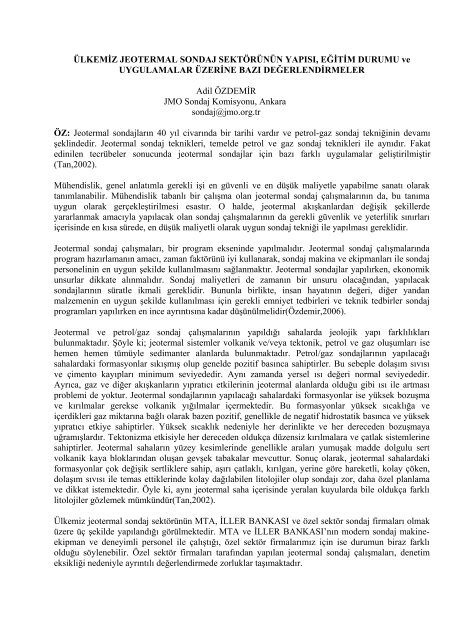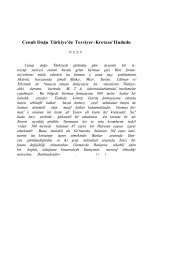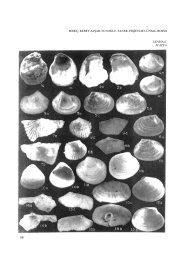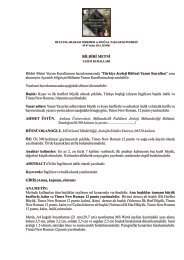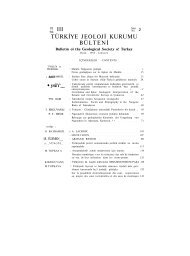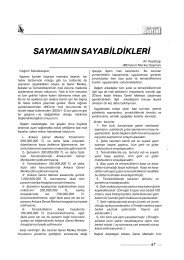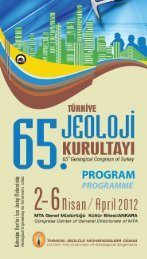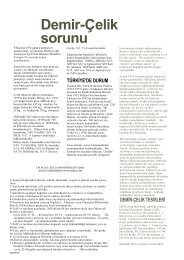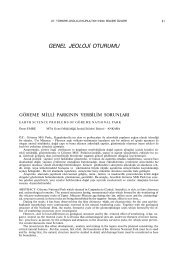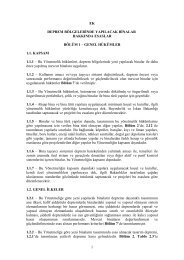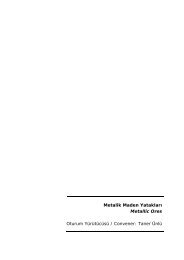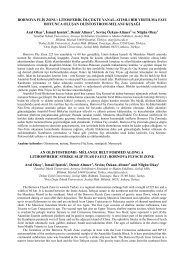ÃLKEMÄ°Z JEOTERMAL SONDAJ SEKTÃRÃNÃN YAPISI, EÄÄ°TÄ°M ve
ÃLKEMÄ°Z JEOTERMAL SONDAJ SEKTÃRÃNÃN YAPISI, EÄÄ°TÄ°M ve
ÃLKEMÄ°Z JEOTERMAL SONDAJ SEKTÃRÃNÃN YAPISI, EÄÄ°TÄ°M ve
You also want an ePaper? Increase the reach of your titles
YUMPU automatically turns print PDFs into web optimized ePapers that Google loves.
ÜLKEMİZ <strong>JEOTERMAL</strong> <strong>SONDAJ</strong> SEKTÖRÜNÜN <strong>YAPISI</strong>, EĞİTİM DURUMU <strong>ve</strong><br />
UYGULAMALAR ÜZERİNE BAZI DEĞERLENDİRMELER<br />
Adil ÖZDEMİR<br />
JMO Sondaj Komisyonu, Ankara<br />
sondaj@jmo.org.tr<br />
ÖZ: Jeotermal sondajların 40 yıl civarında bir tarihi vardır <strong>ve</strong> petrol-gaz sondaj tekniğinin devamı<br />
şeklindedir. Jeotermal sondaj teknikleri, temelde petrol <strong>ve</strong> gaz sondaj teknikleri ile aynıdır. Fakat<br />
edinilen tecrübeler sonucunda jeotermal sondajlar için bazı farklı uygulamalar geliştirilmiştir<br />
(Tan,2002).<br />
Mühendislik, genel anlatımla gerekli işi en gü<strong>ve</strong>nli <strong>ve</strong> en düşük maliyetle yapabilme sanatı olarak<br />
tanımlanabilir. Mühendislik tabanlı bir çalışma olan jeotermal sondaj çalışmalarının da, bu tanıma<br />
uygun olarak gerçekleştirilmesi esastır. O halde, jeotermal akışkanlardan değişik şekillerde<br />
yararlanmak amacıyla yapılacak olan sondaj çalışmalarının da gerekli gü<strong>ve</strong>nlik <strong>ve</strong> yeterlilik sınırları<br />
içerisinde en kısa sürede, en düşük maliyetli olarak uygun sondaj tekniği ile yapılması gereklidir.<br />
Jeotermal sondaj çalışmaları, bir program ekseninde yapılmalıdır. Jeotermal sondaj çalışmalarında<br />
program hazırlamanın amacı, zaman faktörünü iyi kullanarak, sondaj makina <strong>ve</strong> ekipmanları ile sondaj<br />
personelinin en uygun şekilde kullanılmasını sağlanmaktır. Jeotermal sondajlar yapılırken, ekonomik<br />
unsurlar dikkate alınmalıdır. Sondaj maliyetleri de zamanın bir unsuru olacağından, yapılacak<br />
sondajlarının süratle ikmali gereklidir. Bununla birlikte, insan hayatının değeri, diğer yandan<br />
malzemenin en uygun şekilde kullanılması için gerekli emniyet tedbirleri <strong>ve</strong> teknik tedbirler sondaj<br />
programları yapılırken en ince ayrıntısına kadar düşünülmelidir(Özdemir,2006).<br />
Jeotermal <strong>ve</strong> petrol/gaz sondaj çalışmalarının yapıldığı sahalarda jeolojik yapı farklılıkları<br />
bulunmaktadır. Şöyle ki; jeotermal sistemler volkanik <strong>ve</strong>/<strong>ve</strong>ya tektonik, petrol <strong>ve</strong> gaz oluşumları ise<br />
hemen hemen tümüyle sedimanter alanlarda bulunmaktadır. Petrol/gaz sondajlarının yapılacağı<br />
sahalardaki formasyonlar sıkışmış olup genelde pozitif basınca sahiptirler. Bu sebeple dolaşım sıvısı<br />
<strong>ve</strong> çimento kayıpları minimum seviyededir. Aynı zamanda yersel ısı değeri normal seviyededir.<br />
Ayrıca, gaz <strong>ve</strong> diğer akışkanların yıpratıcı etkilerinin jeotermal alanlarda olduğu gibi ısı ile artması<br />
problemi de yoktur. Jeotermal sondajlarının yapılacağı sahalardaki formasyonlar ise yüksek bozuşma<br />
<strong>ve</strong> kırılmalar gerekse volkanik yığılmalar içermektedir. Bu formasyonlar yüksek sıcaklığa <strong>ve</strong><br />
içerdikleri gaz miktarına bağlı olarak bazen pozitif, genellikle de negatif hidrostatik basınca <strong>ve</strong> yüksek<br />
yıpratıcı etkiye sahiptirler. Yüksek sıcaklık nedeniyle her derinlikte <strong>ve</strong> her dereceden bozuşmaya<br />
uğramışlardır. Tektonizma etkisiyle her dereceden oldukça düzensiz kırılmalara <strong>ve</strong> çatlak sistemlerine<br />
sahiptirler. Jeotermal sahaların yüzey kesimlerinde genellikle araları yumuşak madde dolgulu sert<br />
volkanik kaya bloklarından oluşan gevşek tabakalar mevcuttur. Sonuç olarak, jeotermal sahalardaki<br />
formasyonlar çok değişik sertliklere sahip, aşırı çatlaklı, kırılgan, yerine göre hareketli, kolay çöken,<br />
dolaşım sıvısı ile temas ettiklerinde kolay dağılabilen litolojiler olup sondajı zor, daha özel planlama<br />
<strong>ve</strong> dikkat istemektedir. Öyle ki, aynı jeotermal saha içerisinde yeralan kuyularda bile oldukça farklı<br />
litolojiler gözlemek mümkündür(Tan,2002).<br />
Ülkemiz jeotermal sondaj sektörünün MTA, İLLER BANKASI <strong>ve</strong> özel sektör sondaj firmaları olmak<br />
üzere üç şekilde yapılandığı görülmektedir. MTA <strong>ve</strong> İLLER BANKASI’nın modern sondaj makineekipman<br />
<strong>ve</strong> deneyimli personel ile çalıştığı, özel sektör firmalarımız için ise durumun biraz farklı<br />
olduğu söylenebilir. Özel sektör firmaları tarafından yapılan jeotermal sondaj çalışmaları, denetim<br />
eksikliği nedeniyle ayrıntılı değerlendirmede zorluklar taşımaktadır.
Jeotermal sondaj çalışmalarının jeotermal sondaj teknolojisine hakim olmayan mühendisler tarafından<br />
yönetildiği <strong>ve</strong>ya mühendissiz yapıldığı da bilinmektedir. Kanuni düzenlemelerde bu durumun<br />
düzeltilmesi <strong>ve</strong> jeotermal sondaj tekniği konusunda yeterli düzeyde olan mühendisler denetiminde<br />
yapılması şartı getirilmelidir.<br />
Türkiye’de gelişme evresinde olan jeotermal sondaj sektöründeki sorunlardan bir tanesi de sondör<br />
eğitimidir. Jeotermal sondajlarda çalışan sondörlerin çoğu ilkokul mezunudur. Sondörlerin milyon<br />
dolarlık makine <strong>ve</strong>ya kulelerde çalıştığı göz önünde bulundurulursa, sondörlerin eğitim seviyesi<br />
yükseltilmelidir. Sondörler teorik <strong>ve</strong> pratik bilgi ile donatılmalıdır. Türkiye’de sondör eğitimi<br />
problemi çözülmüş değildir. Bu konuda yurt dışı uygulamaları örnek alınmalıdır.<br />
Jeotermal sondaj çalışmalarında görev alan jeoloji mühendislerinin konuya ilişkin deneyimlerini <strong>ve</strong><br />
bilgi birikimlerini artırmaları önem taşımaktadır. Ayrıca, jeotermal konusunda türkçe yayınların<br />
eksikliği de bilinmektedir.<br />
Ülkemizde yapılan jeotermal sondaj çalışmalarında, sondaj çamurunun öneminin yeterince<br />
algılandığını söyleyebilmek maalesef mümkün değildir. Bu durum, jeotermal sondaj çalışmaları<br />
sırasında yaşanılan sondaj güçlüklerinden anlaşılmaktadır. Şöyle ki, killi formasyonlarda yaşanan<br />
şişme, kırıklı formasyonlarda oluşan dolaşım kayıpları gibi sorunları dünya, sondaj kimyasalları <strong>ve</strong>ya<br />
havalı sondaj tekniği ile çözmüşken, bu tekniğin ülkemizde kullanılmasında yeterli düzeye<br />
ulaşılamamıştır.<br />
Türkiye’deki jeotermal sahalar genellikle tektonik alanlarda yayılmış olup fazla çatlaklı (yüksek<br />
ikincil geçirgenlikli) fakat içerdikleri yüksek miktardaki gazlar nedeniyle pozitif hidrostatik basınca<br />
sahiptirler. Bu durum hem sondaj esnasında delinen üst seviyelerde hem de rezervuar seviyelerinde<br />
kendiliğinden gelişe(blow-out) eğilimlidir <strong>ve</strong> ağır çamur kullanılarak kontrol edilmektedir. Oysaki,<br />
dünyadaki diğer jeotermal sahalar genellikle volkanik alanlardadır <strong>ve</strong> negatif basınca sahiptir. Bu<br />
alanlar hem daha çok dolaşım sıvısı kaybı <strong>ve</strong> çimentolama güçlüklerine sebep olmakta hem de üretim<br />
ikincil yöntemlerle başlatılabilmektedir(Tan,2002). Dolayısıyla, sondaj çamuru özellikleri <strong>ve</strong> katkı<br />
maddelerinin iyi bilinmesi <strong>ve</strong> özelliklerinin sondaj çalışmaları sırasında takip edilmesi gereklidir.<br />
Bu sunumda, ülkemiz jeotermal sondaj sektörünün yapılanması, eğitim <strong>ve</strong> uygulamalar irdelenmiş <strong>ve</strong><br />
bazı öneriler getirilmiştir.<br />
ABSTRACT: Geothermal drillings has an approximately 40 years of history and it is like<br />
continuation of oil-gas drilling technique. Geothermal drilling techniques are the same techniques on<br />
the basis with oil and gas drilling techniques, but some different applications are impro<strong>ve</strong>d for<br />
geothermal drillings as a result of experiences obtained. (Tan, 2002)<br />
The engineering may shortly be defined in general meaning as the art of executing the work safely and<br />
with the lowest costs. Geothermal drillings which are based on engineering must be executed in<br />
compliance with this definiton. The drilling works which will be made with a purpose of benefiting<br />
from geothermal solutions in various forms, must be executed in the limits of necessary safety and<br />
capability in shortest time and with least costs and appropriate drilling technique.<br />
Geothermal drilling works must be executed in the axis of a program. The purpose of preparing a<br />
program in geothermal drilling works is to provide the most appropriate usage of rigs, equipments and<br />
drilling personnel, while using time factor well. The economic matters must be considered while<br />
geothermal drilling works are being held. For the drilling costs is a component of time, the drillings<br />
must be executed rapidly. Howe<strong>ve</strong>r, the value of human life and on the other hand, necessary safety
measures and technical measures for the most appropriate usage of the materials must be diligently<br />
thought while preparing drilling programs. (Özdemir, 2006).<br />
There are geological structure differences at where geothermal and oil/gas drilling works are operated.<br />
As the geothermal systems are volcanic and/or tectonic, oil and gas occurences, almost all of them are<br />
found on sedimentary sites. Formations at sites where oil/gas drillings will be operated, are pressed<br />
and ha<strong>ve</strong> generally positi<strong>ve</strong> pressure. For that reason, losses of drilling fluids and cement are at<br />
minimum le<strong>ve</strong>l. At the same time, local temperature value is at normal le<strong>ve</strong>l. Also, increasing of<br />
corrosi<strong>ve</strong> effects of gas and other fluids with temperature as in the geothermal fields is not a problem<br />
faced. Formations at sites where geothermal drillings will be operated contain high alterations and<br />
fractures. These formations contain sometimes positi<strong>ve</strong> but generally negati<strong>ve</strong> hydrostatic pressure and<br />
high corrosi<strong>ve</strong> effect depending on high temperature and gas amount which they contain. They are<br />
altered at e<strong>ve</strong>ry depth and e<strong>ve</strong>ry le<strong>ve</strong>l of alteration because of high temperature. They ha<strong>ve</strong> too many<br />
irregular cracks and fracture systems at e<strong>ve</strong>ry le<strong>ve</strong>l with the effect of tectonism. There are loose layers,<br />
which were formated of hard volcanic rock blocks whose spaces between are filled with soft materials,<br />
at the surface sections of geothermal fields. As a result, formations at geothermal fields which ha<strong>ve</strong><br />
too different hardness like, <strong>ve</strong>ry fractured, breakable, mo<strong>ve</strong>able depending on the area, easily<br />
collapsing, easily dissolving lithologies when contacted with drilling fluids and drillings of these<br />
formations are difficult and need more special planning and attention. So, it is possible to obser<strong>ve</strong> too<br />
different lithologies in wells which exists in the <strong>ve</strong>ry same geothermal field.<br />
The drilling sector of our country is constituted as a trio; MTA, ILLER BANKASI and private sector<br />
drilling companies. It may be told that MTA and ILLER BANKASI worked with modern drilling<br />
machine-equipment and experienced personel while the situation is a bit more different for our private<br />
sector companies.<br />
It is known that geothermal drilling works are being conducted, by engineers who don’t ha<strong>ve</strong> enough<br />
knowledge about geothermal drilling technology or without engineers. This situation must be<br />
corrected with legal regulations and a rule go<strong>ve</strong>rning that geothermal drillings must be conducted<br />
under auditing of engineers who are well qualified in geothermal drillings.<br />
One of the problems in geothermal drilling sector which is in a de<strong>ve</strong>loping phase, is the education of<br />
drillers. Most of the drillers working at geothermal drillings ha<strong>ve</strong> only Primary School diplomas.<br />
Considering that they are working with million dollars machine or rigs, the education le<strong>ve</strong>l of drillers<br />
must be increased. The drillers must be equipped with theorical and practical information. The<br />
problem of driller education is not sol<strong>ve</strong>d yet in Turkiye. Applications of foreign countries must be<br />
taken as examples.<br />
Unfortunately, it is impossible to tell that the importance of drilling mud is understood well in<br />
geothermal drilling Works which are operated in our country. This may be understood from drilling<br />
problems which were experienced during geothermal drilling works. Like that; swelling experienced at<br />
clayey formations and loss circulation at fractured formations etc. are sol<strong>ve</strong>d with drilling chemicals or<br />
air drilling in the world; but we still ha<strong>ve</strong> go<strong>ve</strong>rnmental institutions and drilling companies, leaving<br />
aside the possibility of knowing drilling chemicals in a detailed manner, who don’t know drilling<br />
chemicals and are unaware of the existence of air drilling technique.<br />
Geothermal fields are generally spread at tectonic sites and fractured (high secondary permeability)<br />
and ha<strong>ve</strong> positi<strong>ve</strong> hydrostatic pressure caused by gases in huge amounts they contained. This situation<br />
ha<strong>ve</strong> tendency for blow-out at top le<strong>ve</strong>ls and reservoir le<strong>ve</strong>ls which were drilled during drilling and<br />
they are being controlled using heavy mud. But other geothermal fields on the world are generally at
volcanic sites and ha<strong>ve</strong> negati<strong>ve</strong> pressure. These fields cause more drilling fluid loss and cementation<br />
difficulties and the production here could be commenced with secondary methods. (Tan, 2002). For<br />
that reason, it is best to know features of drilling mud and additi<strong>ve</strong> materials and observing their<br />
properties during drilling works.<br />
In this presentation, organization of geothermal drilling sector, situation of education and applications<br />
are being examined and some recommendations are made.


